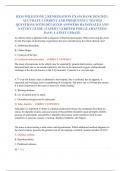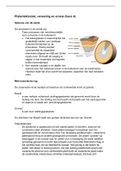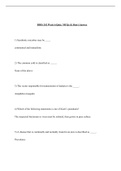HESI MILESTONE 2 REMEDIATION EXAM BANK 2024/2025 |
ACCURATE CURRENT AND FREQUENTLY TESTED
QUESTIONS WITH DETAILED ANSWERS RATIONALES AND
A STUDY GUIDE | EXPERT VERIFIED FOR GUARANTEED
PASS | LATEST UPDATE
An elderly client is admitted with a diagnosis of bacterial pneumonia. When observing the client
for the first signs of decreasing oxygenation, the nurse should assess for which clinical cues?
A. Abdominal distention.
B. Undue fatigue.
C. Cyanosis of the lips.
D. Confusion and tachycardia. - CORRECT ANSWER D
The onset of pneumonia in the elderly may be signaled by general deterioration, confusion,
increased heart rate or increased respiratory rate due to the decreased oxygen- carbon dioxide
exchange at the alveoli, known as the V-Q mismatch. Cyanosis is a very late sign.
A 77-year-old female client is admitted to the hospital. She is confused, has no appetite, is
nauseated and vomiting, and is complaining of a headache. Her pulse rate is 43 beats per minute.
It is most important for the nurse to assess for which finding?
A. Wearing dentures.
B. Use of aspirin prior to admit.
C. Prescribed nitroglycerin for chest pain.
D. Takes digitalis. - CORRECT ANSWER D
Although it is important to obtain a complete medication history, the symptoms described are
classic for digitalis toxicity, and assessment of this problem should be made promptly. Elderly
persons are particularly susceptible to digitalis intoxication which manifests itself in such
symptoms as anorexia, nausea, vomiting, diarrhea, headache, and fatigue.
The nurse is interviewing a male client with hypertension. Which additional medical diagnosis in
the client's history presents the greatest risk for developing a cerebral vascular accident (CVA)?
A. Diabetes mellitus.
B. Hypothyroidism.
C. Parkinson's disease.
1|Page
,D. Recurring pneumonia. - CORRECT ANSWER A
According to the National Stroke Association (2013), history of diabetes mellitus poses the
greatest risk for developing a CVA, 2-4Xs more than those who do not have diabetes mellitus.
The reason for this occurrence is related to the excess glucose circulating throughout the body
not being utilized by the cells, leading to increased fatty deposits or clots inside the blood vessels
in the brain or neck, eventually causing a stroke.
A client with cirrhosis develops increasing pedal edema and ascites. Which dietary modification
is most important for the nurse to teach this client?
A. Avoid high carbohydrate foods.
B. Decrease intake of fat soluble vitamins.
C. Decrease caloric intake.
D. Restrict salt and fluid intake. - CORRECT ANSWER D
Salt and fluid restrictions are the first dietary modifications for a client who is retaining fluid as
manifested by edema and ascites.
A client is admitted to the hospital with a medical diagnosis of pneumococcal pneumonia. The
nurse knows that the prognosis for gram-negative pneumonias (such as E. coli, Klebsiella,
Pseudomonas, and Proteus) is very poor. Which information relates most directly to the
prognosis for gram-negative pneumonias?
A. The gram-negative infections occur in the lower lobe alveoli which are more sensitive to
infection.
B. Gram-negative organisms are more resistant to antibiotic therapy.
C. Usually occur in healthy young adults who have recently been debilitated by an upper
respiratory infection.
D. Gram-negative pneumonias usually affect infants and small children. - CORRECT ANSWER
B
Gram-negative organisms are very resistant to drug therapy which makes recovery difficult.
Antibiotic resistance has become a world-wide concern and the World Health Organization is
keeping a very close surveillance on these occurrences.
A client is admitted to the hospital with a diagnosis of severe acute diverticulitis. Which
assessment finding should the nurse expect this client to exhibit?
2|Page
,A. Lower left quadrant pain and a low-grade fever.
B. Severe pain at McBurney's point and nausea.
C. Abdominal pain and intermittent tenesmus.
D. Exacerbations of severe diarrhea. - CORRECT ANSWER A
Left lower quadrant pain occurs with diverticulitis because the sigmoid colon is the most
common area for diverticula, and the inflammation of diverticula causes a low-grade fever.
The registered nurse (RN) assesses arterial blood gas results of a client that has emphysema.
Which finding is consistent with respiratory acidosis?
A. pH 7.32, pCO 2 46 mmHg, HCO 3 24 MEq/L.
B. pH 7.45 , pCO 2 37 mmHg, HCO 3 24 mEq/L.
C. pH 7.34, pCO 2 36 mmHg, HCO 3 21 mEq/L.
D. pH 7.46, pCO 2 35 mmHg, HCO 3 28 mEq/L. - CORRECT ANSWER A
Normal ABG ranges are pH 7.35 to 7.45; pCO2 35 to 45 mmHg; HCO3 21 to 28 mEq/L, and
pO2 80 to 100 mmHg. An ABG of pH 7.32, pCO2 46 mmHg, HCO3 24 MEq/L represents a
client with respiratory acidosis which is characterized by: low pH, pCO2 higher than normal, and
HCO3 within normal limits.
Which nail color alteration should the nurse expect to observe in a client with chronic kidney
disease?
A. Horizontal white banding.
B. Diffuse blue discoloration.
C. Diffuse brown discoloration.
D. Thin, dark red vertical lines. - CORRECT ANSWER A
Fingernails and toenails can be affected by chronic kidney disease. This condition may cause
horizontal white lines or bands (leukonychia) to appear on the nails.
A client with diabetes mellitus is experiencing polyphagia. Which outcome statement is the
priority for this client?
A. Fluid and electrolyte balance.
B. Prevention of water toxicity.
3|Page
, C. Reduced glucose in the urine.
D. Adequate cellular nourishment. - CORRECT ANSWER D
Diabetes mellitus Type 1 is characterized by hyperglycemia that precipitates glucosuria and
polyuria (frequent urination), polydipsia (excessive thirst), and polyphagia (excessive hunger).
Polyphagia is a consequence of cellular malnourishment when insulin deficiency prevents
utilization of glucose into the cell for energy, so the outcome statement should include
stabilization of adequate cellular nutrition which is done by providing the insulin supplement the
client needs.
The nurse notes that a client who is scheduled for surgery the next morning has an elevated blood
urea nitrogen (BUN) level. Which condition is most likely to have contributed to this finding?
A. Myocardial infarction 2 months ago
B. Anorexia and vomiting for the past 2 days
C. Recently diagnosed type 2 diabetes mellitus
D. Skeletal traction for a right hip fracture - CORRECT ANSWER B
The blood urea nitrogen (BUN) level indicates the effectiveness of the kidneys in filtering waste
from the blood. Dehydration, which could be caused by vomiting, would cause an increased
BUN level. Option A would affect serum enzyme levels, not the BUN level. Option C would
primarily affect the blood glucose level; renal failure that could increase the BUN level would be
unlikely in a client newly diagnosed with type 2 diabetes. Effects of option D might affect the
complete blood count (CBC) but would not directly increase the BUN level.
Which nursing action would be appropriate for a client who is newly diagnosed with Cushing
syndrome?
A. Monitor blood glucose levels daily.
B. Increase intake of fluids high in potassium.
C. Encourage adequate rest between activities.
D. Offer the client a sodium-enriched menu. - CORRECT ANSWER A
Cushing syndrome results from a hypersecretion of glucocorticoids in the adrenal cortex. Clients
with Cushing syndrome often develop diabetes mellitus. Monitoring of serum glucose levels
assesses for increased blood glucose levels so that treatment can begin early. A common finding
in Cushing syndrome is generalized edema. Although potassium is needed, it is generally
obtained from food intake, not by offering potassium-enhanced fluids. Fatigue is usually not an
4|Page






